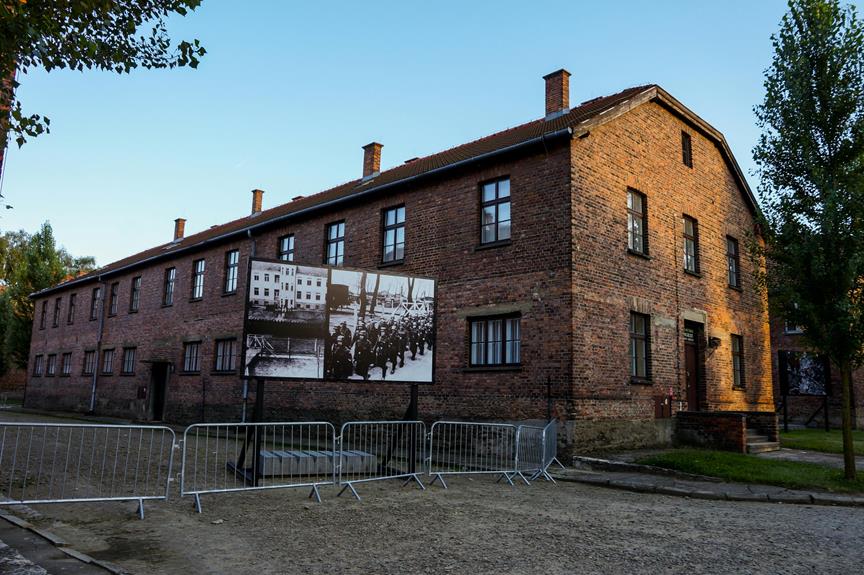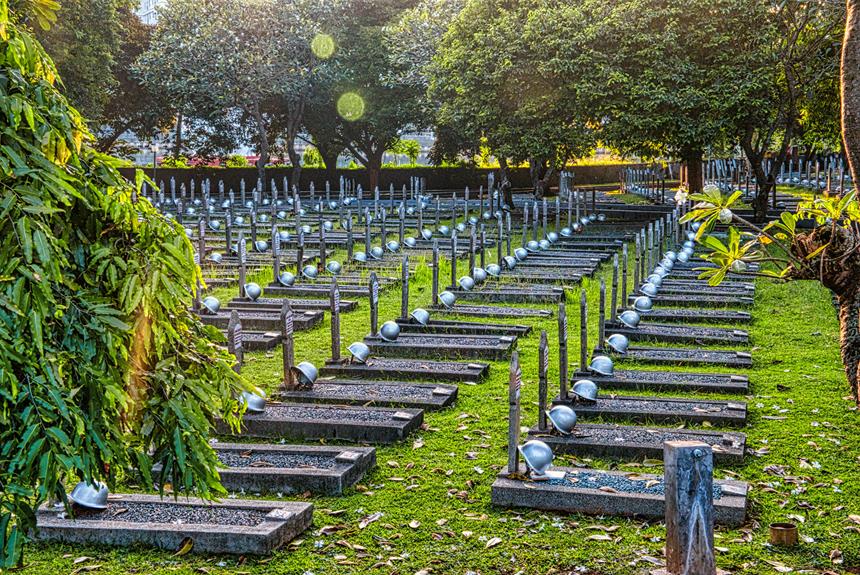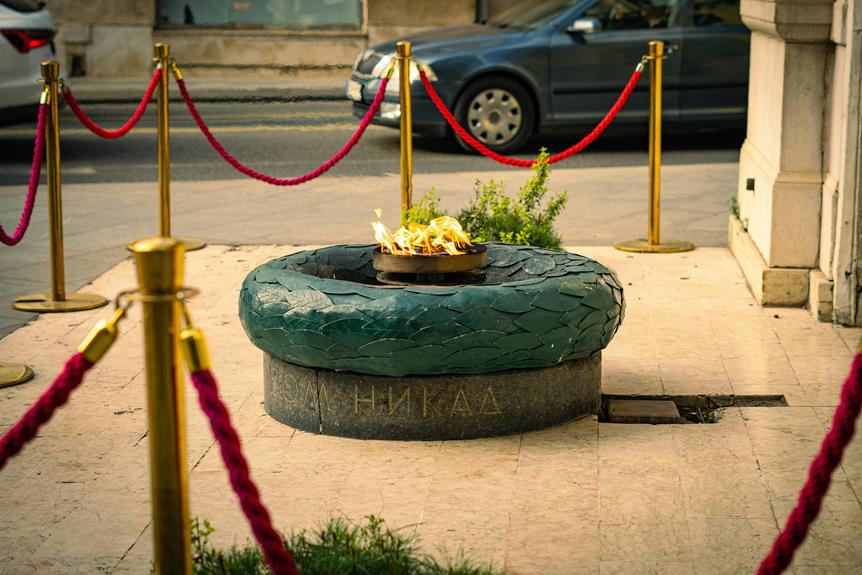Stepping into the Tuol Sleng Genocide Museum in Cambodia is like entering a harrowing portal to a dark chapter of human history, where the echoes of suffering linger within the confines of its walls. The museum's stark displays and haunting silence offer a glimpse into the depths of inhumanity that occurred within its premises. However, beyond the chilling exterior lies a narrative that beckons contemplation on the resilience of the human spirit amidst adversity. This site serves as a stark reminder of the atrocities that transpired, prompting reflection on the enduring lessons it holds for present and future generations.
Key Takeaways
- Originated from Security Prison 21 (S-21) under the Khmer Rouge regime.
- Serves as a memorial to 20,000 victims, educating about past atrocities.
- Preserves artifacts and records, raising awareness about the genocide.
- Houses prisoner interrogation rooms with torture implements and reminders.
- Survivor testimonies reflect resilience, empowering against forgetting atrocities.
History and Origins
The history and origins of the Tuol Sleng Genocide Museum in Cambodia trace back to its harrowing past as Security Prison 21 (S-21) during the Khmer Rouge regime. Established by the Khmer Rouge under the leadership of Pol Pot in the 1970s, S-21 was a center for the detention, interrogation, torture, and execution of perceived enemies of the regime. The site witnessed unspeakable atrocities, with an estimated 20,000 prisoners passing through its gates, most of whom were later executed.
The transformation of S-21 into the Tuol Sleng Genocide Museum holds immense historical significance, serving as a stark reminder of the brutalities committed during the Khmer Rouge regime. The museum stands as a memorial to the victims, preserving the memory of those who suffered and perished within its walls. It plays a vital role in educating visitors about the atrocities that occurred, ensuring that the horrors of the past are not forgotten.
Through its origins and the atrocities it witnessed, the Tuol Sleng Genocide Museum stands as a tribute to the resilience of the human spirit and the importance of upholding freedom and human rights. It serves as a poignant reminder of the consequences of totalitarianism and the necessity of safeguarding liberty and justice for all.
Exhibits and Documentation
Amidst the haunting echoes of its dark past, the Tuol Sleng Genocide Museum meticulously showcases exhibits and documentation that vividly depict the horrors endured within its walls during the Khmer Rouge regime.
- Preservation Efforts: The museum's commitment to preserving historical artifacts, photographs, and written records from the Khmer Rouge era is evident. Through rigorous conservation methods, these items are safeguarded to guarantee they continue to serve as poignant reminders of the atrocities committed.
- Educational Outreach: Tuol Sleng Genocide Museum actively engages in educational outreach programs to raise awareness about the genocide. By hosting lectures, workshops, and guided tours, the museum plays an essential role in educating visitors, especially the younger generation, about the importance of understanding history to prevent such tragedies from recurring.
- Visitor Impact: The exhibits and documentation have a profound impact on visitors, evoking a range of emotions from shock and sadness to reflection and empathy. Many leave the museum with a renewed sense of appreciation for peace and a commitment to human rights advocacy.
- Emotional Response: The raw and unfiltered nature of the displays often elicits emotional responses from visitors. The authenticity of the artifacts and documentation serves as a powerful tool in ensuring that the memory of the victims is honored and that their stories are never forgotten.
Prisoner Interrogation Rooms
Within the somber confines of Tuol Sleng Genocide Museum, the prisoner interrogation rooms stand as stark reminders of the harrowing experiences endured by those who were once held within their walls. These rooms were the heart of the Khmer Rouge's brutal regime, where prisoners were subjected to a range of interrogation techniques designed to elicit confessions or information. The stark, windowless chambers echo with the silent screams of the past, bearing witness to the psychological trauma inflicted upon those who were detained within.
The interrogation rooms at Tuol Sleng were equipped with shackles, implements of torture, and haunting reminders of the atrocities committed. Prisoners were subjected to physical abuse, sleep deprivation, and psychological manipulation in an effort to break their spirits and extract information. The walls of these rooms hold the memories of countless individuals who suffered within them, their stories etched into the very fabric of the building.
The use of such interrogation techniques not only inflicted immediate physical pain but also left deep psychological scars on those who survived. The enduring trauma of their experiences serves as a stark warning of the horrors that can be inflicted upon individuals in the name of ideology. Visiting these rooms serves as a sobering reminder of the importance of safeguarding freedom and human rights, lest we allow such atrocities to be repeated.
Survivors' Stories
Numerous firsthand testimonies provide profound insight into the enduring impact of the atrocities witnessed at Tuol Sleng Genocide Museum, Cambodia. Survivors' stories shed light on the human suffering and resilience in the face of unimaginable horrors. These personal accounts offer a glimpse into the deep scars left by the Khmer Rouge regime and the challenges faced by survivors in their journey towards healing and recovery.
Key Points:
- Trauma Recovery: Survivors' testimonies highlight the long and arduous healing process that follows the trauma experienced at Tuol Sleng. Many continue to grapple with psychological wounds, seeking solace and understanding.
- Personal Accounts: Each survivor carries a unique story of survival and loss, providing a poignant reminder of the individual lives affected by the genocide. These personal narratives humanize the tragedy, making it more relatable and impactful.
- Challenges Faced: The testimonies reveal the ongoing challenges faced by survivors, including feelings of guilt, fear, and the struggle to rebuild their lives in the aftermath of such devastation.
- Resilience and Hope: Despite the harrowing experiences recounted, survivors' stories also reflect remarkable resilience and hope. Through sharing their testimonies, many find a sense of empowerment and a renewed purpose in ensuring that the world never forgets the atrocities committed at Tuol Sleng.
Importance of Remembering
It is imperative to acknowledge the profound significance of remembering the atrocities documented at the Tuol Sleng Genocide Museum in Cambodia. Memorializing atrocities such as those displayed at Tuol Sleng is vital not only for honoring the victims but also for educating current and future generations about the horrors of genocide. By preserving the memory of the atrocities committed during the Khmer Rouge regime, the museum serves as a poignant reminder of the consequences of unchecked power and the importance of upholding human rights.
The educational value of remembering the atrocities at Tuol Sleng extends beyond mere historical documentation. It provides a unique opportunity for visitors to engage with the past, fostering empathy and understanding for the victims and their families. Through interactive exhibits and survivor testimonies, the museum offers a glimpse into the lived experiences of those who suffered under the Khmer Rouge, challenging visitors to reflect on the fragility of freedom and the dangers of totalitarianism.
Moreover, remembering the atrocities at Tuol Sleng serves as a call to action, urging individuals and societies to stand against injustice and oppression. By confronting the dark chapters of history, we equip ourselves with the knowledge and empathy necessary to prevent such atrocities from happening again. In essence, the act of remembering is not just a tribute to the past but a commitment to a future built on justice, freedom, and human dignity.
Frequently Asked Questions
Are Visitors Allowed to Take Photographs Inside the Museum?
Photography rules within museums vary depending on the institution's policies and the cultural significance of the artifacts. Tourist behavior regarding photography should align with respect for the historical context and sensitivity towards subjects.
Understanding the balance between capturing memories and preserving the sanctity of a space is critical. It is advisable for visitors to adhere to any guidelines provided by the museum to guarantee a harmonious experience for all.
How Long Does the Average Visitor Spend Touring the Museum?
When exploring museums, have you ever pondered about the ideal duration for a visitor's tour?
Visitor experience is deeply intertwined with the museum layout, impacting tour duration and evoking a range of emotions.
Understanding the average time spent touring a museum is vital in catering to visitor needs and ensuring a fulfilling experience.
Are There Any Specific Security Measures in Place at the Museum?
Security protocols play an essential role in ensuring visitor safety at cultural institutions worldwide. Museums often implement measures such as surveillance cameras, trained security personnel, bag checks, and restricted access to sensitive areas. These protocols are designed to safeguard both the artifacts on display and the individuals visiting the museum.
Can Visitors Leave Personal Items as a Tribute at the Museum?
Visitors to memorial sites often wish to leave personal items as tributes, reflecting the cultural significance of honoring the deceased. However, it is crucial to take into account visitor etiquette and historical context when deciding to leave items at such sites.
While some places may allow for the placement of tributes, it is advisable to check for specific guidelines or restrictions to guarantee respect for the memorial and its significance.
Are There Any Special Events or Exhibitions Held at the Museum Throughout the Year?
Throughout the year, the museum hosts a variety of special events, exhibitions, workshops, commemorations, and cultural performances. These activities serve to educate visitors, honor the memory of those affected by the past events, and provide a deeper understanding of the historical significance of the site.
Conclusion
To sum up, the Tuol Sleng Genocide Museum in Cambodia stands as a significant historical site, preserving the memory of the atrocities committed during the Khmer Rouge regime.
One striking statistic is that out of the estimated 20,000 prisoners held at S-21, only a handful survived.
This serves as a stark reminder of the importance of remembering the past to prevent such tragedies from occurring again.


